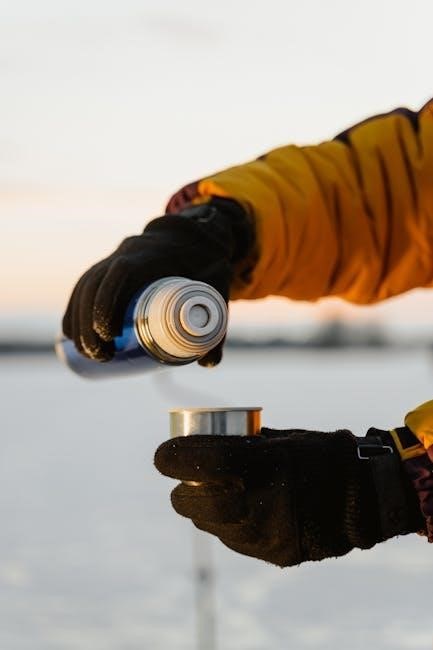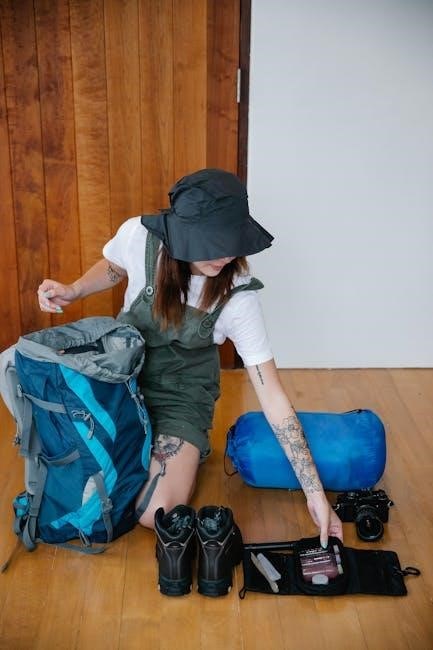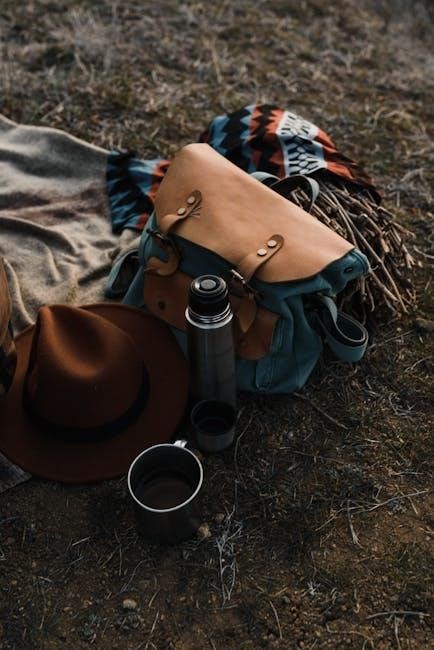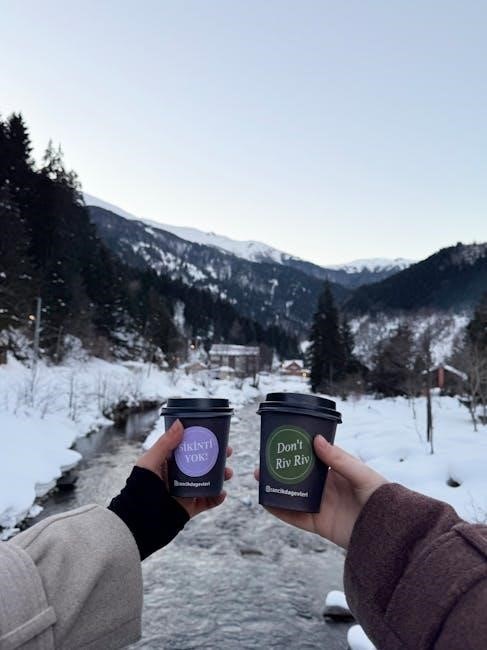The 10 Essentials for Hiking are critical for safety and survival, originating from The Mountaineers in the 1930s to ensure preparedness in wilderness adventures․ They help hikers navigate, adapt, and respond to challenges․
1․1 Importance of Preparedness in Hiking
Preparedness is vital for a safe and enjoyable hiking experience․ Carrying the 10 Essentials ensures you can navigate, adapt to changing conditions, and handle emergencies․ Unpredictable weather, injuries, or getting lost highlight the need for readiness․ Being prepared enhances confidence, allowing hikers to focus on the journey and connect with nature responsibly․
1․2 Brief History of the 10 Essentials
The 10 Essentials were first introduced in the 1930s by The Mountaineers, a Seattle-based outdoor organization․ Initially created for climbers, the list evolved to include critical items for all wilderness activities․ This foundational framework has since become a widely accepted standard for hikers, emphasizing safety and self-reliance in nature․

Navigation Tools
Navigation tools are vital for staying on course․ A map and compass remain reliable, while GPS devices and apps offer modern convenience․ Always carry a backup like a paper map and compass․
2․1 Map and Compass
A detailed topographic map and a reliable compass are timeless navigation essentials․ The map provides terrain features, while the compass ensures accurate direction-finding․ Always carry them, as GPS devices can fail or lose battery․
2․2 GPS Devices and Apps
GPS devices and hiking apps offer precise navigation, especially in unmarked trails․ They complement maps and compasses but can be unreliable due to battery drain or signal loss․ Always carry extra batteries and know how to use a map and compass as a backup for safer wilderness exploration․

Lighting
Lighting is crucial for visibility and safety during early morning or late evening hikes․ A reliable headlamp or flashlight ensures you can navigate and set up camp in the dark․
3․1 Headlamp or Flashlight
A headlamp or flashlight is essential for visibility in low-light conditions․ Choose a bright, reliable option with red light mode to preserve night vision․ Adjustable brightness and water resistance are key features․ A headlamp is preferable for hands-free use, while extra batteries ensure uninterrupted light during your hike․
3․2 Extra Batteries
Extra batteries are crucial to keep your headlamp or flashlight functioning․ Carry a sufficient supply in a protective case to prevent damage․ Ensure compatibility with your light source and consider environmental factors that may drain power․ Packing extra batteries guarantees reliable light during your hike, preventing unexpected darkness․
Sun and Insect Protection
Protect yourself from harmful UV rays and insect bites with sunglasses, sunscreen, and insect repellent․ These essentials ensure comfort and safety during outdoor adventures, preventing sunburn and bug-related discomfort․
4․1 Sunglasses
Sunglasses are vital for protecting your eyes from harmful UV rays, especially at high altitudes or near water․ Opt for polarized lenses to reduce glare and enhance visibility․ They also shield your eyes from dust and debris, ensuring clear vision and comfort throughout your hike․ Pack spare glasses for emergencies to maintain eye protection continuously․
4․2 Sunscreen
Sunscreen is essential to prevent sunburn and skin damage, especially at higher elevations where UV exposure is intense․ Choose a broad-spectrum SPF 30 or higher and reapply every two hours, even on cloudy days․ Lip balm with SPF protects your lips from wind and sun, ensuring comprehensive skin protection during your outdoor adventure․
4․3 Insect Repellent
Insect repellent is vital to protect against bites from mosquitoes, ticks, and other insects, which can transmit diseases like Lyme or Zika․ Opt for repellents containing DEET, picaridin, or oil of lemon eucalyptus․ Apply as directed and reapply after swimming or sweating․ This ensures protection during outdoor adventures, keeping you comfortable and safe from insect-borne risks․
Emergency Shelter
Emergency shelter provides protection from harsh weather and unexpected overnight stays․ Lightweight options like tarps or bivvy sacks are essential for safety and preventing exposure․
5․1 Lightweight Tent or Tarp
A lightweight tent or tarp is essential for emergency shelter, offering quick setup and protection from rain, wind, and cold․ Compact designs minimize weight while ensuring durability․ Choose models with waterproof materials and sturdy poles for reliability in harsh conditions․ Always consider the number of people and weather extremes when selecting your shelter․
5․2 Emergency Bivvy Sack
An emergency bivvy sack is a compact, lightweight shelter solution for unexpected situations․ Made of waterproof and breathable materials, it provides essential protection from elements․ Ideal as a backup to a tent or tarp, it helps retain body heat, increasing survival chances in harsh conditions․ Always include it in your hiking essentials for added safety․

Fire Starters
Fire starters are crucial for warmth, cooking, and signaling․ Carry reliable matches, a lighter, or a firesteel․ Ensure they are waterproof for emergencies․
6․1 Matches or Lighter
Matches or a lighter are essential fire starters․ Opt for waterproof matches or a windproof lighter․ Always carry extras in a sealed container to ensure reliability in damp conditions․ These tools are vital for starting fires, which provide warmth, light, and a way to cook during hikes or unexpected overnights in the wilderness․
6․2 Firesteel
A firesteel is a durable, weather-resistant alternative to matches or lighters․ It generates sparks to ignite tinder, even in wet conditions․ Compact and lightweight, it’s a reliable backup for fire starting, ensuring you can build a fire for warmth, light, and cooking, even when other methods fail during your hiking adventures․

First Aid Kit
A first aid kit is essential for treating minor injuries and preventing infections during hikes․ It includes bandages, antiseptics, pain relievers, and other supplies to handle emergencies effectively․
7․1 Bandages and Wound Care
Bandages and wound care supplies are crucial for treating cuts and scrapes․ Include assorted sizes of band-aids, gauze pads, and rolls to cover and protect wounds effectively․ Antibiotic ointment helps prevent infection, ensuring minor injuries don’t escalate into bigger issues during your hike․ Proper wound care promotes healing and keeps you moving safely on the trail․
7․2 Pain Relievers and Medications
Pack pain relievers like ibuprofen or acetaminophen for muscle aches and headaches․ Include antihistamines for allergic reactions and antidiarrheal medication for stomach issues․ Don’t forget personal medications and any necessary prescriptions․ Ensure all items are within expiration dates and stored securely․ A small first aid guide can also help in administering the right dosage for common ailments․
Food and Water
Carry enough water for your hike duration and pack lightweight, high-energy snacks․ Water purification options are essential for longer trips and uncertain water sources․ Plan accordingly․
8․1 Water Bottle or Hydration Bladder
A water bottle or hydration bladder is essential for staying hydrated․ Choose a durable, BPA-free option that fits your pack․ Consider capacity based on hike length and water availability․ Ensure it’s easy to clean and resistant to leaks․ For longer trips, pair with a water purification method to refill safely from natural sources․
8․2 Water Purification Tablets or Filter
Water purification tablets or a filter ensure safe drinking water from natural sources․ Tablets are lightweight and easy to use, while filters remove bacteria, viruses, and parasites․ Both options are crucial for preventing waterborne illnesses․ Choose based on hike duration, group size, and water source reliability to stay hydrated safely and sustainably․
8․3 High-Energy Snacks
High-energy snacks provide essential nutrients and sustained energy during hikes․ Opt for lightweight, non-perishable options like nuts, dried fruits, jerky, and energy bars․ These snacks help maintain stamina, preventing fatigue and supporting physical performance․ Always carry enough to cover the duration of your hike and share with group members if needed․

Extra Clothing
Extra clothing is vital for adapting to varying weather and physical exertion․ Include moisture-wicking base layers, insulating mid-layers, and a waterproof jacket to stay comfortable and dry․
9․1 Moisture-Wicking Base Layers
Moisture-wicking base layers are essential for managing sweat during hikes․ They keep skin dry, reducing chafing and discomfort․ Opt for breathable, quick-drying fabrics like merino wool or synthetic materials to maintain comfort throughout your journey․ These layers are crucial for regulating body temperature in varying weather conditions, ensuring a pleasant hiking experience․ Always pack extras for extended trips․
9․2 Insulating Layer or Jacket
An insulating layer or jacket is vital for retaining body heat in cold conditions․ Choose materials like fleece, synthetic insulation, or down for warmth․ It helps maintain core temperature during breaks or in cooler weather, preventing hypothermia․ A lightweight, breathable option is ideal for versatility, ensuring comfort without restricting movement during your hike․
9․3 Waterproof Jacket
A waterproof jacket is essential for shielding against rain and wind, keeping you dry and comfortable․ Look for breathable, waterproof materials like Gore-Tex or similar technology․ A good fit allows layering and movement, while a hood provides additional protection․ It’s a crucial item for unpredictable weather conditions during hikes․
Multi-Purpose Tool
A multi-purpose tool, like a Swiss Army knife or Leatherman, is versatile for cutting, tightening, and repairing gear․ Its portability and functionality make it indispensable for hiking emergencies․
10․1 Pocket Knife
A pocket knife is a compact, versatile tool essential for hiking․ It aids in cutting branches, repairing gear, and opening packages․ Choose a durable model with multiple functions for wilderness emergencies, ensuring reliability when needed most․ Its portability makes it a must-have for any outdoor adventure, enhancing safety and convenience․
10․2 Duct Tape
Duct tape is a versatile and essential tool for hiking, offering quick fixes for gear repairs and preventing blisters․ Its lightweight design makes it easy to carry, ensuring you’re prepared for wilderness emergencies․ Use it to secure loose items, reinforce clothing, or even create makeshift solutions, making it a practical addition to your hiking kit․
Planning and Safety Tips
Always check weather and trail conditions, inform someone about your itinerary, and stay alert to your surroundings to ensure a safe and enjoyable hiking experience․
11․1 Checking Weather and Trail Conditions
Checking weather and trail conditions is crucial for safe hiking․ Use reliable sources like NOAA or local forecasts for accurate updates․ Trail conditions can be affected by recent weather, so check official park websites or ranger stations․ Adjust plans if trails are unsafe due to snowmelt, mud, or other hazards․ Always carry navigation tools for unexpected route changes․
11․2 Informing Someone About Your Itinerary
Informing someone about your hiking itinerary is crucial for safety․ Share your route, expected return time, and emergency contacts․ Leave a detailed plan with a trusted person to ensure help can reach you quickly if needed․ This practice enhances safety and provides peace of mind for both hikers and their loved ones․
Staying Aware of Your Surroundings
Staying aware of your surroundings is vital for a safe hiking experience․ Pay attention to trail signs, weather changes, and potential hazards like wildlife or uneven terrain․ Keeping an eye on your environment helps prevent accidents and ensures you stay on track․ Vigilance enhances your connection with nature and keeps you prepared for unexpected situations․




